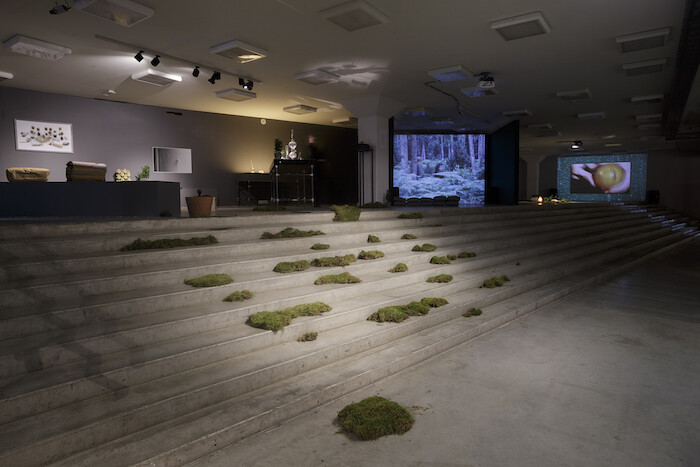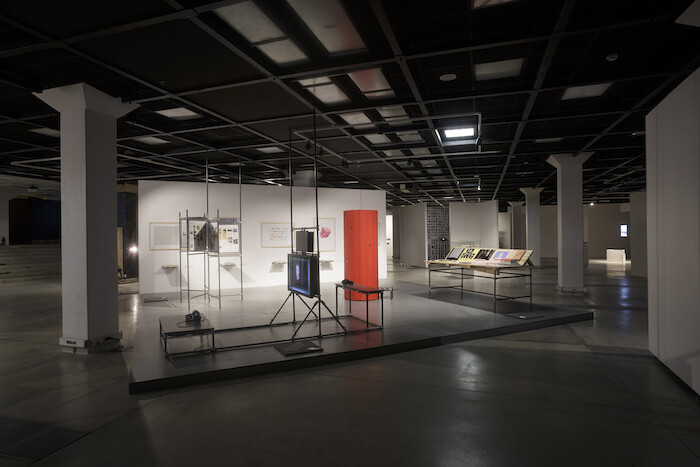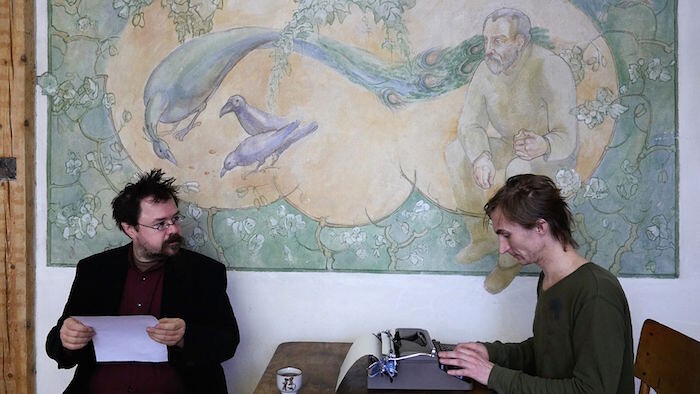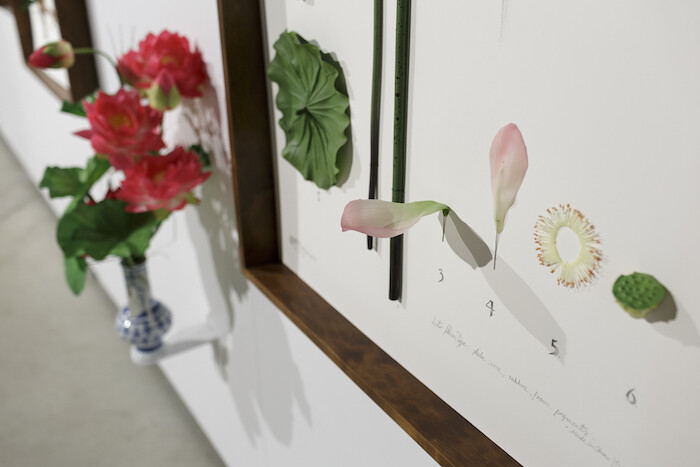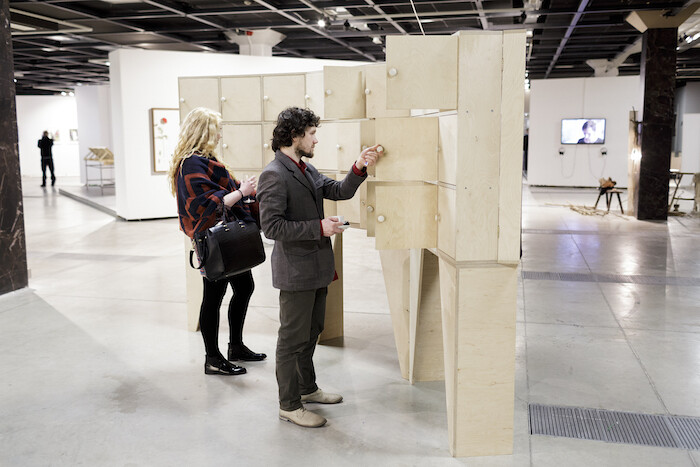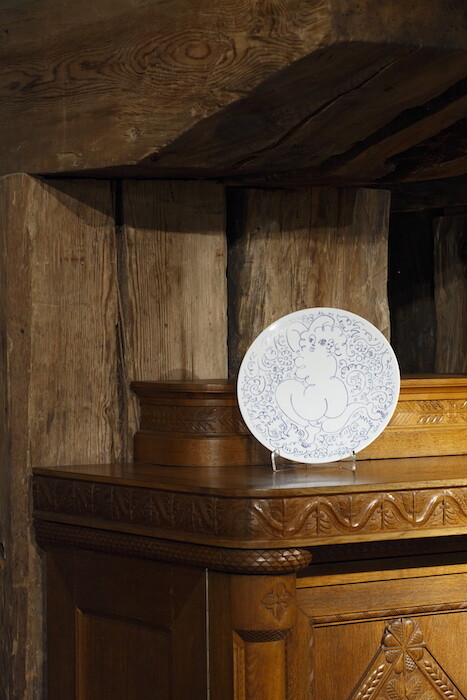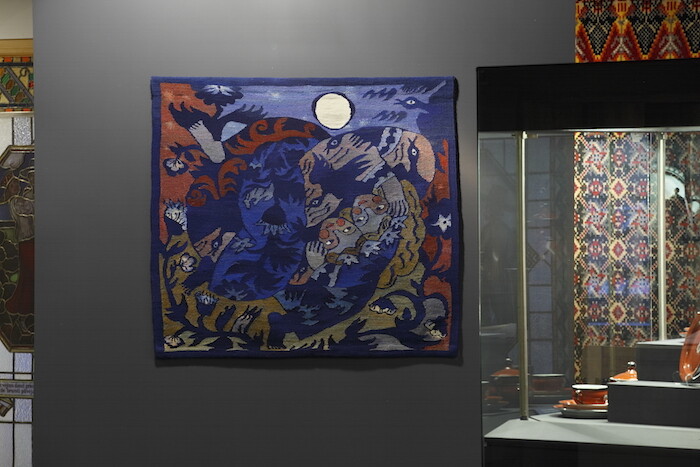A man goes back and forth, slowly, silently, carefully balancing framed paintings and works on paper. He transports them from a pile perched atop a canyon to a Mondrianesque storage grid positioned on another peak nearby. From beginning to end, he walks on a tightrope. Shot against the spectacular background of the mountains of the Caucasus, the 73-minute video Tightrope (2015) by Daghestani-Russian artist Taus Makhacheva is a natural testimonial for “Lost in the Archive,” a group show organized by the Latvian Centre for Contemporary Art (LCCA) at the Riga Art Space, a vast underground exhibition hall at the heart of Old Riga.
Tightrope is a clear, visually powerful allegory for the difficulties of juggling with heritage and memory, of performing and preserving them, and making them travel across time and space. A tricky exercise, especially in the context of a “peripheral” post-Soviet culture which allocates modest means to the task. The artworks are reproductions of the Daghestani Museum of Fine Arts’ collection from the late nineteenth century to the year 2000.
By contrast, the almost invisible installation Untitled (from the series “Cannot Think in Words,” 2016) by Lithuanian artist Žilvinas Landzbergas, who mimetically dressed up a few of the gallery’s columns in faux marble, so that they now recall a grandiose institutional building, deflates the rhetoric of the “museum.” It also exposes its inclination towards reframing history by means of art history, while often concealing what Walter Benjamin called “the recent past,” the outmoded modernity of the years that just preceded us, whose traces are the hardest to acknowledge in the present. After all, the Baltic states (Estonia, Latvia, Lithuania), in their present form of independent parliamentary democracies, are only 25 years old.
The defining character of “Lost in the Archive,” curated and neatly installed by Inga Lāce and Andra Silapētere, lies in the clever, somehow bipolar combination of two interpretations of its title: the first one is literal and site-specific, with works based on the LCCA’s rich documentation of exhibitions, events, and projects held in Latvia over the last couple of decades. Opened in 1993 as the Soros Center for Contemporary Arts with the mandate to map and propel Riga’s local art scene, it progressively expanded the scope of its research and publishing activity to include the Soviet era, too quickly repressed and forgotten, after the American philanthropist George Soros withdrew his financial support in 1999. The LCCA then became an independent organization, mainly supported by public funding. The video The Guidelines (2016) by Estonian artist Tanel Rander shows a man trying to record, on an old typewriter, the guidelines initially provided to all Soros centers, in order to streamline, homologate, catalogue, and “modernize” the recordings of each one’s history and present. “The concept of contemporaneity,” Rander explains in the exhibition’s catalogue, “was exposed as an extra space between the old and holy and the new and desirable. Not as a political option—but as an ideological drive for the execution of neoliberal policy.”
The other thread of “Lost in the Archive” is (geographically, chronologically, ironically) divergent, and tackles memory and postcolonialism on a broader scale. The Herbarium of Artificial Plants (2002-ongoing) by Colombian artist Alberto Baraya, applies Linnaeus’s taxonomy to artificial plants, mostly plastic and Made in China, obtained from friends or “collected” (i.e. lifted) from hotels and public lobbies. The Cabinet of Folksongs 2.0 (2013–16) by Latvian artist Ivars Drulle is a collection of contemporary folklore, exhibited in the form of short videos inserted in a wooden cabinet, where Baltic ancestral identity is crossed with nostalgia, exoticism, and new rituals, like that of a couple of Bedouin men happily dancing together, or a red sports car racing along a lake. I am still haunted by the absurdist wit of one of the digital videos of the multimedia installation Lietas [Things] (2016) by The Centre of Tragic Research (Kaspars Groševs, Ainārs Kamoliņš, and Daiga Kažociņa), where a real shrimp, locked in a glass tank, is forced to run with its many legs and pleopods on a minuscule treadmill, and clumsily tries to keep up with the fast pace. Welcome to the zoo of advanced capitalism!
Since regaining independence, Latvia has been on an economic rollercoaster, with fast cycles of collapse and recovery: after joining the EU in 2004, the country was severely hit by the financial crisis in 2008. Growth returned in 2010, and now the country’s economy ranks among the liveliest in Europe, thanks to strong exports, although the international sanctions against Russia are affecting the balance. Like Makhacheva’s equilibrist, the contemporary art scene in Riga seems caught in a moment of suspension, in between relocations, instability, and future optimism. On March 4, The Latvian National Museum of Art will reopen its main building after three years of extensive renovation, during which temporary exhibitions were hosted by the (slightly shabby) Arsenāls hall across the park. The plans for a new contemporary art museum, whose initial project (now cancelled) in the harbor area was designed by Rem Koolhaas during the boom years, have been postponed to 2020, and the private/public partnership due to sustain it is still under construction. In the meantime, Jānis Zuzāns, the country’s most prominent collector (whose artworks, mainly paintings, are on display at Mūkusalas Art Salon, opened to the public in 2011) is said to be developing his own postwar art museum.
LCCA has only a small exhibition space at its headquarters, on the elegant Alberta iela (the area of foreign embassies, just off the center, rich in Riga’s trademark Art Nouveau architectures by Michail Osipovič Ėjzenštejn, the father of avant-garde film director Sergej). Every summer, it migrates across the city, in search of a hub for its popular art festival Survival Kit, where artists and collectives are invited to deploy “alternative modes of survival.” Started in 2009, when the crisis shut and vacated many parts of the urban area, the festival continues to reclaim space for public use: stickers that read “Occupy me,” created by the movement Free Riga in 2014, a grassroots spin-off of Survival Kit, are still visible on many empty properties. The last site used by the project, in September 2015, was an amazing neoclassical building on Krišjāņa Barona iela that hosted the National Library of Latvia from 1956 to 2014. The large white sign reading “Survival Kit” still takes up the entire front window, while the LCCA red logo looms above an eloquent “For Sale” notice. In 2014, the library moved to its new premises, a Ziggurat/mountain-shaped megastructure dubbed “Castle of Light,” designed by Latvian-born US architect Gunārs Birkerts and built on the other side of the Daugava river, from where it now towers over the entire city with—involuntary, I reckon—Soviet-style titanism.
The active and internationally well-connected kim? Contemporary Art Centre (from the Latvian kas ir māksla? or “what is art?”), also founded in 2009, just closed the doors of its old space, a brick warehouse next to Riga’s amazing and lively Central Market, and is waiting to sign the agreement for a new venue “in the neighborhood of Riga New Theatre,” director Zane Onckule told me. In the meantime, it will be nomadic: its first off-site project is the current solo by Alexandra Zuckerman at the Museum of Decorative Arts and Design, while the XII Baltic Triennial, WHAT IS AN ARTWORK TODAY CAN BE SOMETHING ELSE ENTIRELY TOMORROW—organized by kim? in collaboration with CAC in Vilnius, where it made its debut last year—will land in March in a still undisclosed large “theater lobby.”
At the moment, one of the few steady meeting places in town is 427, the room-sized artist-run space opened by Kaspars Groševs and Ieva Kraule in 2014 at the far end of Stabu iela, away from the tourist routes, where the young crowds and art academy students gather and, occasionally, dance at openings. “We like the idea of providing a space where it’s possible to play with ideas, make mistakes and mess up, without being immediately ‘too clean’ and identifiable,” says Groševs. We talked while sitting on Marija Olsauskaite’s dusty and tilted Stage (2010), a section of an inlaid wooden floor that once belonged to the Ministry of Education, now turned into an installation on view at 427 as part of the group exhibition “Joy and Mirror. Port City.” Lost histories keep on returning.

